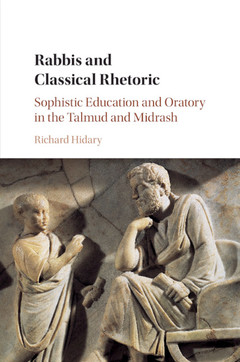Description
Rabbis and Classical Rhetoric
Sophistic Education and Oratory in the Talmud and Midrash
Author: Hidary Richard
Shows the unique perspective of Talmudic rabbis as they navigate between platonic objective truth and the realm of rhetorical argumentation.
Language: English
Subject for Rabbis and Classical Rhetoric:
Approximative price 30.28 €
In Print (Delivery period: 14 days).
Add to cart
Rabbis and Classical Rhetoric
Publication date: 09-2019
Support: Print on demand
Publication date: 09-2019
Support: Print on demand
Approximative price 115.29 €
In Print (Delivery period: 14 days).
Add to cart
Rabbis and Classical Rhetoric
Publication date: 12-2017
344 p. · 15.8x23.5 cm · Hardback
Publication date: 12-2017
344 p. · 15.8x23.5 cm · Hardback
Description
/li>Contents
/li>Biography
/li>
Training in rhetoric - the art of persuasion - formed the basis of education in the Roman Empire. The classical intellectual world centered around the debate between philosophers, who boasted knowledge of objective reality, and sophists, who could debate both sides of any issue and who attracted large audiences and paying students. The roles of the Talmudic rabbis as public orators, teachers, and jurists, parallel that of Roman orators. Rabbinic literature adopted and adapted various aspects of the classical rhetorical tradition, as is demonstrated in the Talmudic penchant for arguing both sides of hypothetical cases, the midrashic hermeneutical methods, and the structure of synagogue sermons. At the same time, the rabbis also resisted the extreme epistemological relativism of rhetoric as is evident in their restraint on theoretical argumentation, their depiction of rabbinic and divine court procedure, and their commitment to the biblical prophetic tradition. Richard Hidary demonstrates how rabbis succeeded in navigating a novel path between platonic truth and rhetorical relativism.
Introduction; 1. Rabbis as orators: the setting and structure of rabbinic homilies; 2. Rabbis as instructors: rhetorical arrangement and reasoning in the Yerushalmi; 3. The agonistic Bavli: Greco-Roman rhetoric in Sasanian Persia; 4. Progymnasmata and controversiae in rabbinic literature; 5. Talmudic topoi: rhetoric and the hermeneutical methods of Midrash; 6. The role of lawyers in Roman and rabbinic courts; 7. Why are there lawyers in heaven?; Conclusion: rabbinic versus Christian approaches to rhetoric.
Richard Hidary received a Ph.D. from New York University and is Associate Professor of Judaic Studies at Yeshiva University where he teaches courses in Second Temple Jewish history, Dead Sea Scrolls, and rabbinic literature in its cultural context. He is the author of Dispute for the Sake of Heaven: Legal Pluralism in the Talmud (2010) and his articles appear in Association for Jewish Studies Review, Conversations, Dead Sea Discoveries, Dine Israel, Encyclopedia Judaica, Encyclopedia of the Bible and Its Reception, Jewish Studies an Internet Journal, and Okimta. He has been a fellow at Cardozo Law School's Center for Jewish Law and Legal Theory, an affiliate scholar at The Tikvah Center and a Starr fellow at Harvard University's Center for Jewish Studies.
© 2024 LAVOISIER S.A.S.
These books may interest you

Rabbinic JudaismSpace and Place 48.88 €

Rabbinic JudaismSpace and Place 223.58 €


